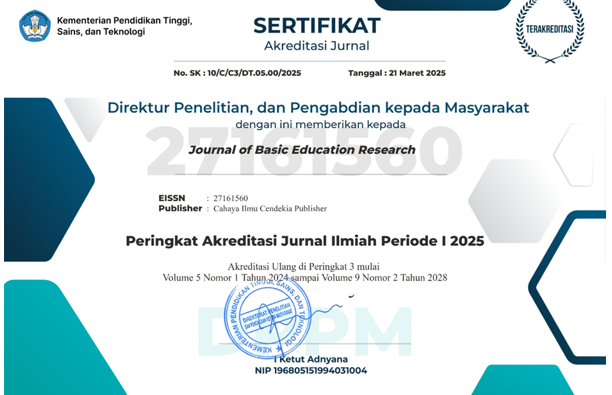Pragmatic Analysis of Social Meaning of Indonesian Language Towards Arabic Language Translation
Abstract
Purpose of the study: This research aims to analyzing the pragmatics of the social meaning of Indonesian which is then translated into Arabic
Methodology: This study uses a qualitative method with a comparative study type of research, with a pragmatic analysis approach, the data source of this study is coption and speech acts of adolescents. The data collection technique of this researcher is the listening and recording technique.
Main Findings: The speech acts of teenagers who follow the language of social media result in the person they are communicating with not being able to receive the information that the speaker wants to convey, this is what can result in different pragmatic social meanings.
Novelty/Originality of this study: There are pragmatic differences in social meaning related to expressions of anger, disappointment, sadness and admiration in Indonesian which are then translated into Arabic. These expressions and speech acts differ in terms of the pragmatics of social meaning
References
S. Effendi, “Linguistik sebagai ilmu bahasa,” J. Perspekt. Pendidik., vol. 5, no. 1, p. 10, 2012.
Y. Kusnawati, “Analisis Fungsi Bahasa Arab Berdasarkan Fungsi Utama Bahasa Menurut Halliday,” J. Bhs. Arab, vol. 12, no. 1, pp. 67–76, 2023.
A. Rahmatika Halil, “Linguistik bahasa arab persepektif dr. h. sahkholid nasution, s.ag, ma dalam buku ‘pengantar linguistik bahasa arab,’” Αγαη, vol. 15, no. 1, pp. 37–48, 2024.
M. R. Ponny, “Linguistik dalam perspektif ibnu jinni dan ferdinand de saussure,” Al-Mashadir, vol. 2, no. 01, pp. 40–56, 2022, doi: 10.30984/almashadir.v2i01.251.
Zulkiflih and Fitria, “Studi makna teks bahasa arab dalam teori kontekstual/study of the meaning of arabic texts in contextual theory,” LOGHAT Arab. J. Bhs. Arab dan Pendidik. Bhs. Arab, vol. 4, no. 1, pp. 112–123, 2023.
R. Abdurrahman, “Peran nazhariyah al-siyaq (teori kontekstual) dalam memahami makna Al-Quran,” Ihya al-Arabiyah J. Pendidik. Bhs. dan Sastra Arab, vol. 4, no. 2, pp. 143–156, 2018.
Muzaiyanah, “Jenis makna dan perubahan makna,” Wardah, no. 25, pp. 145–152, 2015.
Y. Wahyudin and D. N. Rahayu, “Analisis metode pengembangan sistem informasi berbasis website: a literatur review,” J. Interkom J. Publ. Ilm. Bid. Teknol. Inf. dan Komun., vol. 15, no. 3, pp. 26–40, 2020, doi: 10.35969/interkom.v15i3.74.
Rizki Fitriani and Nadella Lesmana, “Pengaruh penggunaan teknologi terhadap perkembangan kemampuan berbahasa indonesia pada generasi milenial,” Blaz. J. Bhs. dan Sastra dalam Pendidik. Linguist. dan Pengembangan, vol. 2, no. 2, pp. 148–156, 2024, doi: 10.59841/blaze.v2i2.1206.
B. Widiatmoko and W. Waslam, “Interjeksi dalam bahasa indonesia: analisis pragmatik,” Pujangga, vol. 3, no. 1, p. 87, 2017, doi: 10.47313/pujangga.v3i1.330.
S. N. N. M. Nasir and M. Yusof, “Sorotan literatur bersistematik kajian bahasa komunikasi di internet dari sudut pragmatik,” GEMA Online J. Lang. Stud., vol. 22, no. 2, pp. 185–204, 2022, doi: 10.17576/gema-2022-2202-10.
R. K. Rahardi, “Memerikan fungsi konteks situasi dalam perspektif pragmatik siber,” Linguist. Indones., vol. 40, no. 2, pp. 197–211, 2022, doi: 10.26499/li.v40i2.286.
N. R. Pertiwi, H. N. Sabila, and A. Sintawati, “Implementasi model pembelajaran problem based learning terhadap keterampilan kolaboratif dan komunikasi sains pada materi sistem ekskresi di kelas VIII B SMP Negeri 1 Ciamis,” Bioed J. Pendidik. Biol., vol. 11, no. 1, p. 47, 2023, doi: 10.25157/jpb.v11i1.10168.
M. K. Asamoah, “Sturdiness and scuffle in deploying educational technologies for teaching and learning in a low-technology context: Students’ experience in a developing society,” African J. Sci. Technol. Innov. Dev., vol. 0, no. 0, pp. 1–18, 2020, doi: 10.1080/20421338.2020.1773604.
A. Bala, “Kajian tentang hakikat, tindak tutur, konteks, dan muka dalam pragmatik,” Retorika J. Pembelajaran Bhs. dan Sastra Indones., vol. 3, no. 1, pp. 36–45, 2022, doi: 10.37478/rjpbsi.v3i1.1889.
Z. N. Gustina, “Interaksi simbolik tim pendukung lgbt pada piala dunia 2022 article history,” J. Ilmu Komun., vol. 2, no. 1, pp. 1–8, 2023.
A. S. Ariliani Virliya Medina Milasari, “Makna simbolik tradisi megengan bagi warga desa ngadirojo Ponorogo,” Paradigma, vol. 11, no. 1, pp. 1–19, 2022.
D. P. Ningrum, “Jogja walking tour sebagai alternatif berwisata kaum muda (analisis interaksi sosial berdasarkan perspektif herbert blumer),” Scriptura, vol. 14, no. 1, pp. 14–24, 2024, doi: 10.9744/scriptura.14.1.14-24.
F. Sumaya, “Makna Sosial dalam Pendidikan bagi Masyarakat di Desa Sungai Jaga B Kecamatan Sungai Raya Kabupaten Bengkayang,” Sociologique, vol. 5, no. 2, pp. 1–19, 2017.
B. Baharuddin, M. Amin, L. Thohir, and L. A. Wardana, “Penerapan teori terjemahan pada editing hasil terjemahan google translate pada teks akademik oleh mahasiswa universitas Mataram,” J. Ilm. Profesi Pendidik., vol. 6, no. 4, pp. 816–824, 2022, doi: 10.29303/jipp.v6i4.390.
R. H. Latifah and I. Rohmaniyah, “Analisis sastra dalam terjemahan al-qur’an karya arthur john arberry: the holy qur’an,” Jalsah J. Al-quran As-sunnah Stud., vol. 4, no. 1, pp. 53–76, 2024, doi: 10.37252/jqs.v4i1.783.
N. Anandita, D. Gumilar, A. Racmadhany, S. Lupin, and K. Kompleks, “Analisis teknik terjemahan aplikasi dan reduksi pada takarir seri lupin melalui platfrom streaming netlix,” vol. 8, pp. 2326–2335, 2025.
Y. Zhou et al., “Rayleigh–taylor and richtmyer–meshkov instabilities: a journey through scales,” Phys. D Nonlinear Phenom., vol. 423, 2021, doi: 10.1016/j.physd.2020.132838.
M. A. Bangun, M. F. A. Nasution, N. R. Sinaga, S. F. D. Sastra, and W. Khairani, “Analisis pengaruh media sosial terhadap perkembangan bahasa indonesia di era globalisasi,” J. Bhs. Drh. Indones., vol. 1, no. 3, p. 9, 2024, doi: 10.47134/jbdi.v1i3.2646.
S. M. Baharuddin, N. Dwinda, and P. Aminuddin, “Analisis pragmatik makna lokusi pada lirik lagu iklan teh pucuk versi 2020,” vol. 03, no. 02, pp. 573–580, 2025.
M. Kh. A. D. R. Gustiasari, “Analysis of the meaning of hate speech in the instagram account @ lambe _ turah ( pragmatic study ),” vol. 1, no. 1, pp. 176–183, 2025.
A. M. Hasni, B. Angelina, C. S. Ramadina, S. R. Sari, V. Syhana, and E. Z. Sinaga, “Analisis tindak tutur dalam komunikasi komunitas lgbt : kajian pragmatik terhadap pola bahasa dan makna dalam interaksi sosial analysis of speech act in lgbt community communication : a pragmatic study of language patterns and meaning in social interactio,” no. April, pp. 6441–6450, 2025.
N. D. Astri, “Analisis tindak tutur lokusi, ilokusi, dan perlokusi dalam cuitan atau meme di media sosial instagram,” J. Bhs. Indones. Prima, vol. 2, no. 2, pp. 20–30, 2020, doi: 10.34012/bip.v2i2.1187.
N. A. Syahkila, S. P. D. Nanda, T. Maharani, and S. H. Harahap, “Analisis puisi ‘seratus untai biji tasbih’ karya raudah jambak dengan pendekatan pragmatik,” IJEDR Indones. J. Educ. Dev. Res., vol. 2, no. 1, pp. 320–327, 2024, doi: 10.57235/ijedr.v2i1.1765.
P. Pranowo and D. Febriasari, “Fungsi bahasa dan makna pragmatik dalam media sosial untuk memerangi Covid-19: Kajian etnopragmatik,” Bahastra, vol. 40, no. 2, p. 104, 2020, doi: 10.26555/bahastra.v40i2.17306.
R. U. Ali, I. A. Aziz, and A. R. Ibnu, “Studi komparasi minat masyarakat menggadai emas di bank syariah indonesia dan pegadaian syariah,” NISBAH J. Perbank. Syariah, vol. 9, no. 1, pp. 21–31, 2023, doi: 10.30997/jn.v9i1.8448.
A. D. Milniadi and N. O. Adiwijaya, “Analisis perbandingan model arima dan lstm dalam peramalan harga penutupan saham (studi kasus : 6 kriteria kategori saham menurut peter lynch),” SIBATIK J. J. Ilm. Bid. Sos. Ekon. Budaya, Teknol. dan Pendidik., vol. 2, no. 6, pp. 1683–1692, 2023, doi: 10.54443/sibatik.v2i6.798.
A. M. Ayudia, L. Ramadhani, and R. W. Lubis, “Deiksis dalam film guru-guru gokil: analisis pragmatik,” J. Bhs. dan Sastra, vol. 6, no. 1, pp. 20–34, 2021.
Feni Amanda Putri and Achmad Yuhdi, “Analisis makna konotasi dalam lirik lagu ‘sampai jadi debu’ karya ananda badudu,” ENGGANG J. Pendidikan, Bahasa, Sastra, Seni, dan Budaya, vol. 4, no. 1, pp. 247–260, 2023, doi: 10.37304/enggang.v4i1.12137.
Copyright (c) 2025 Ulir Rizqiyah, Syamsul Anam, Asep Maulana

This work is licensed under a Creative Commons Attribution 4.0 International License.
Authors who publish with this journal agree to the following terms:
- Authors retain copyright and acknowledge that the Journal of Basic Education Research is the first publisher licensed under a Creative Commons Attribution 4.0 International License.
- Authors are able to enter into separate, additional contractual arrangements for the non-exclusive distribution of the journal's published version of the work (e.g., post it to an institutional repository or publish it in a book), with an acknowledgment of its initial publication in this journal.
- Authors are permitted and encouraged to post their work online (e.g., in institutional repositories or on their website) prior to and during the submission process, as it can lead to productive exchanges and earlier and greater citation of published work.





.png)


.png)
.png)


















